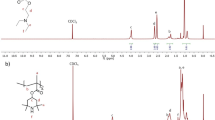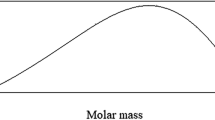Abstract
This investigation reports the analysis of different microstructures present in poly(methyl methacrylate) (PMMA) using1D and 2D NMR spectroscopy. The PMMA used in this study has been prepared via activators regenerated by electron transfer atom transfer radical polymerization (ARGET-ATRP) in DMF at ambient temperature using methyl 2-chloro propionate (MCP) as initiator, CuBr2 as catalyst in combination with N, N, N´, N´´, N´´- pentamethyldiethylenetriamine (PMDETA) as ligand and ascorbic acid as reducing agent.13C NMR, which provides good information about tacticity of a polymer, has been used extensively along with 1H NMR spectroscopy to extract the information about the different microstructures present in PMMA. Heteronuclear multiple-bond correlation (HMBC), heteronuclear single-quantum coherence (HSQC), and total correlation spectroscopy (TOCSY) were also used to study the position of protons, couplings with carbon etc. in the PMMA.










Similar content being viewed by others
References
Matyjaszewski K, Xia J (2001) Atom transfer radical polymerization. Chem Rev 101:2921–2990
Hajifatheali H, Ahmadi E, Marefat M (2020) Synthesis of N-benzyl-2-(dodecylthio)-N-(2-(dodecylthio) ethyl) ethanamine: new ligand for block copolymerization of styrene and methyl methacrylate using ATRP. J Polym Res 27:22–30
Deoghare C, Srivastava H, Behera RN, Chauhan R (2019) Microstructure analysis of copolymers of substituted itaconimide and methyl methacrylate: experimental and computational investigation. J Polym Res 26(8):204–218
Rabea AM, Zhu S (2015) Modeling the influence of diffusion-controlled reactions and residual termination and deactivation on the rate and control of bulk ATRP at high conversions. Polymers. 7:819–835
Rabea AM, Zhu S (2014) Controlled radical polymerization at high conversion: bulk ICAR ATRP of methyl methacrylate. Ind Eng Chem Res 53:3472–3477
Matyjaszewski K, Tsarevsky NV, Braunecker WA, Dong H, Huang J, Jakubowski W, Kwak Y, Nicolay R, Tang W, Yoon JA (2007) Role of Cu0 in controlled/“living” radical polymerization. Macromolecules. 40:7795–7806
Grishin ID, Stakhi SA, Kurochkina DY, Grishin DF (2018) Controlled copolymerization of acrylonitrile with methyl acrylate and dimethyl itaconate via ARGET ATRP mechanism. J Polym Res 25:261–268
Ahmadian-Alam L, Haddadi-Asl V, Roghani-Mamaqani H, Hatami L, Salami-Kalajahi M (2012) Use of clay-anchored reactive modifier for the synthesis of poly (styrene-co-butyl crylate)/clay nanocomposite via in situ AGET ATRP. J Polym Res 19:9773–9784
Izunobi JU, Higginbotham CL (2011) Polymer molecular weight analysis by 1H NMR spectroscopy. J Chem Educ 88:1098–1104
Brar AS, Singh G, Shankar R (2004) Structural investigations of poly(methyl methacrylate) by two-dimensional NMR. J Mol Struct 703:69–81
Miri MJ, Pritchard BP, Cheng HN (2011) A Versatile approach for modelling and simulating the tacticity of polymers. J Mol Model 17:1767–1780
Ghosh P, Das T, Nandi D (2011) Synthesis characterization and viscosity studies of Homopolymer of methyl methacrylate and copolymer of methyl methacrylate and styrene. J Solut Chem 40:67–78
Quinting G, Cai R (1994) High-Resoltion NMR analysis of the Tacticity of poly(n-butyl methacrylate). Macromolecules 27:6301–6306
Bujak P, Henzel N, Matlengiewicz M (2007) Microstudy study of poly(tert-butyl acrylate) by 13C NMR spectroscopy. J Polym Anal Charact 12:431–443
Hornby BD, West AG, Tom JC, Waterson C, Harrisson S, Perrier S (2010) Copper(0)-mediated living radical polymerization of methyl methacrylate in a non-polar solvent. Macromol Rapid Commun 31:1276–1280
Mcbriety VJ, Douglass DC, Kwei TK (1978) Compatibility in blends of poly(methyl methacrylate) and poly(styrene-co-acrylonitrile). 2. An NMR study. Macromolecules. 11:1265–1267
Nguyen G, Nicole D, Swistek M, Matlengiewicz M, Wiegert B (1997) Sequence distribution of the methyl methacrylate-ethyl acrylate copolymer by 13C NMR spectroscopy. Polymer 38:3455–3461
Pasich M, Henzel N, Matlengiewicz M (2013) Sequence distribution of poly(methyl acrylate)by incremental calculation. Int J Polym Anal Charact 18:105–118
Brar AS, Goyal AK, Hooda S (2009) Two dimensional NMR studies of acrylate copolymers. Pure Appl Chem 81:389–415
McCord EF, Anton WL, Wilczek L, Ittel SD, Nelson LTJ, Raffell KD, Hanson JE, Berge C (1994) 1H and 13C NMR of PMMA macromonomers and oligomers- end group and tacticity. Macromol Symp 86:47–64
Dhar A, Koiry P, Haloi DJ (2018) Synthesis of poly(methyl methacrylate) via ARGET ATRP and study of the effect of solvents and temperatures on its polymerization kinetics. Int J Chem Kinet 50:1–7
Brar AS, Kaur S (2005) Microstructure determination of methyl methacrylate and n-butyl acrylate copolymers synthesized by atom transfer radical polymerization with two-dimensional NMR spectroscopy. J Polym Sci A Polym Chem 43:1100–1118
Kotyk JJ, Berger PA, Remsen EE (1990) Microstructure characterization of poly(methyl methacrylate)using proton-detected heteronuclear shift-correlated NMR spectroscopy. Macromolecules 23:5167–5169
Kawamura T, Toshima N, Matsuzaki K (1993) Assignments of finely resolved 13C NMR spectra of poly(methyl methacrylate). Makromol Chem Rapid Commun 14:719–724
Acknowledgements
The Financial support from Science and Engineering Research Board (DST-SERB) (Grant no ECR/2015/000075), Govt. of India is greatly appreciated.
Author information
Authors and Affiliations
Corresponding author
Additional information
Publisher’s note
Springer Nature remains neutral with regard to jurisdictional claims in published maps and institutional affiliations.
Rights and permissions
About this article
Cite this article
Dhar, A., Singh, U., Koiry, B.P. et al. Investigation of microstructure in poly(methyl methacrylate) prepared via ambient temperature ARGET-ATRP: a combined approach of 1D and 2D NMR spectroscopy. J Polym Res 27, 174 (2020). https://doi.org/10.1007/s10965-020-02153-x
Received:
Accepted:
Published:
DOI: https://doi.org/10.1007/s10965-020-02153-x




